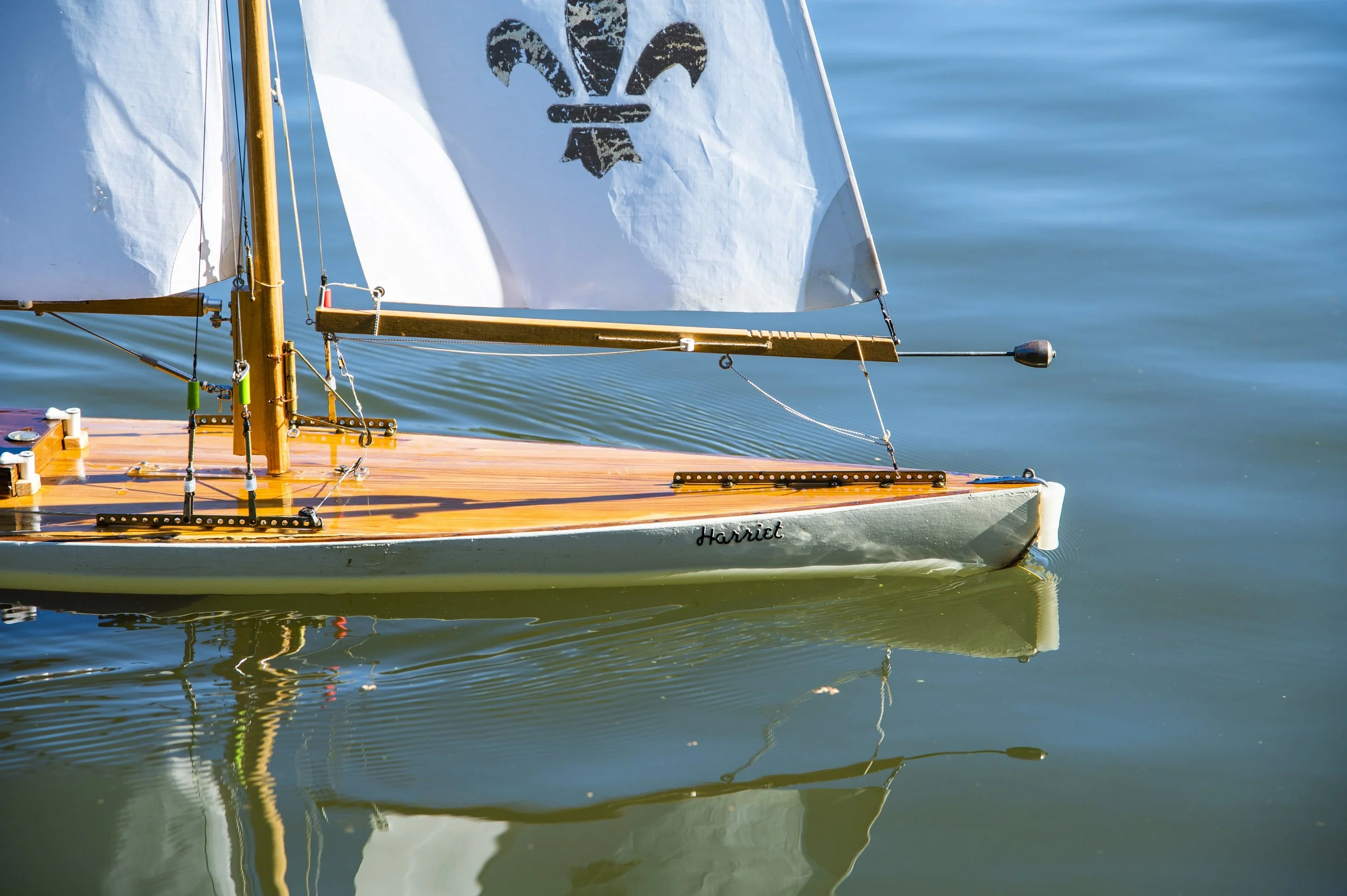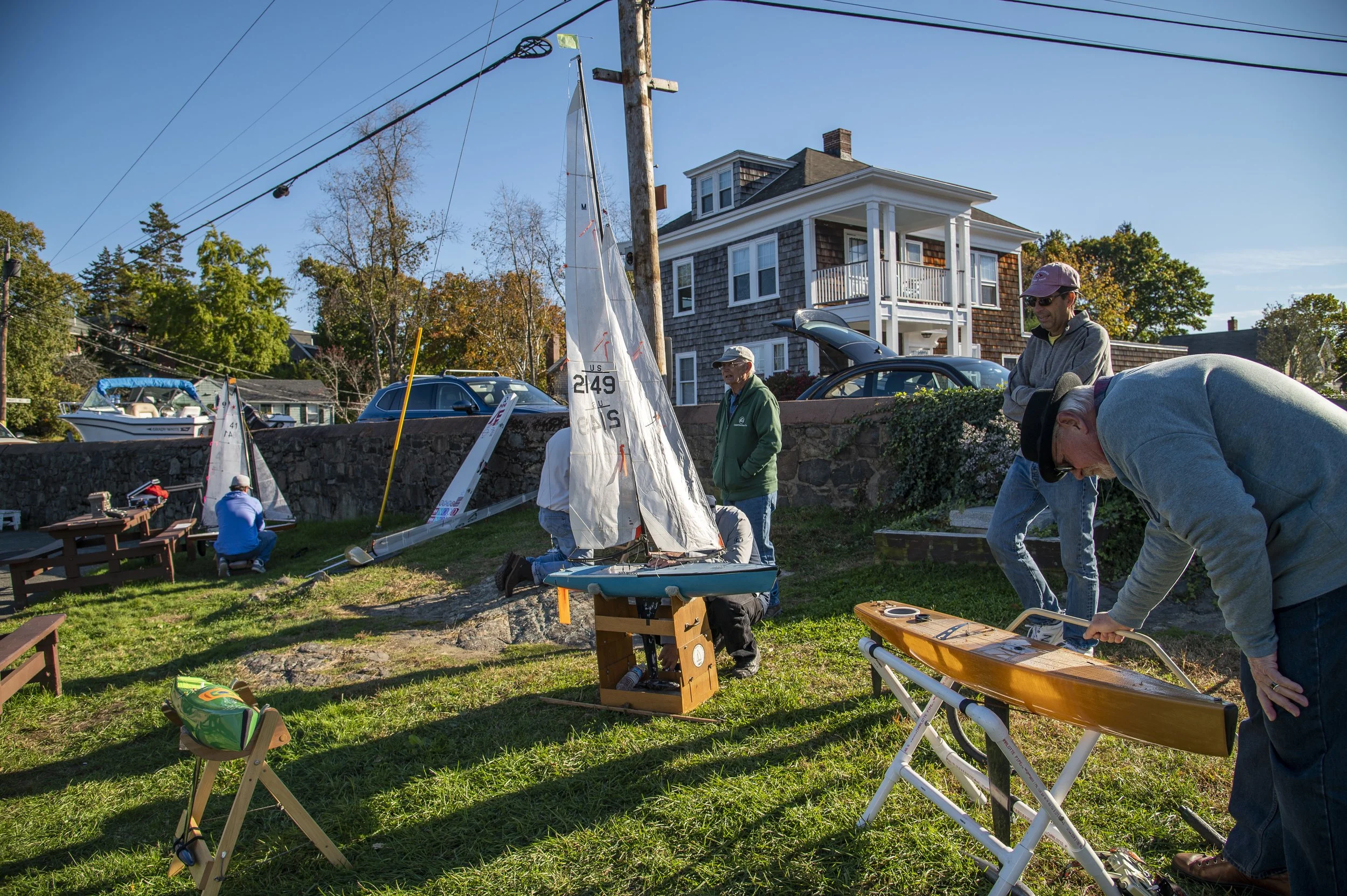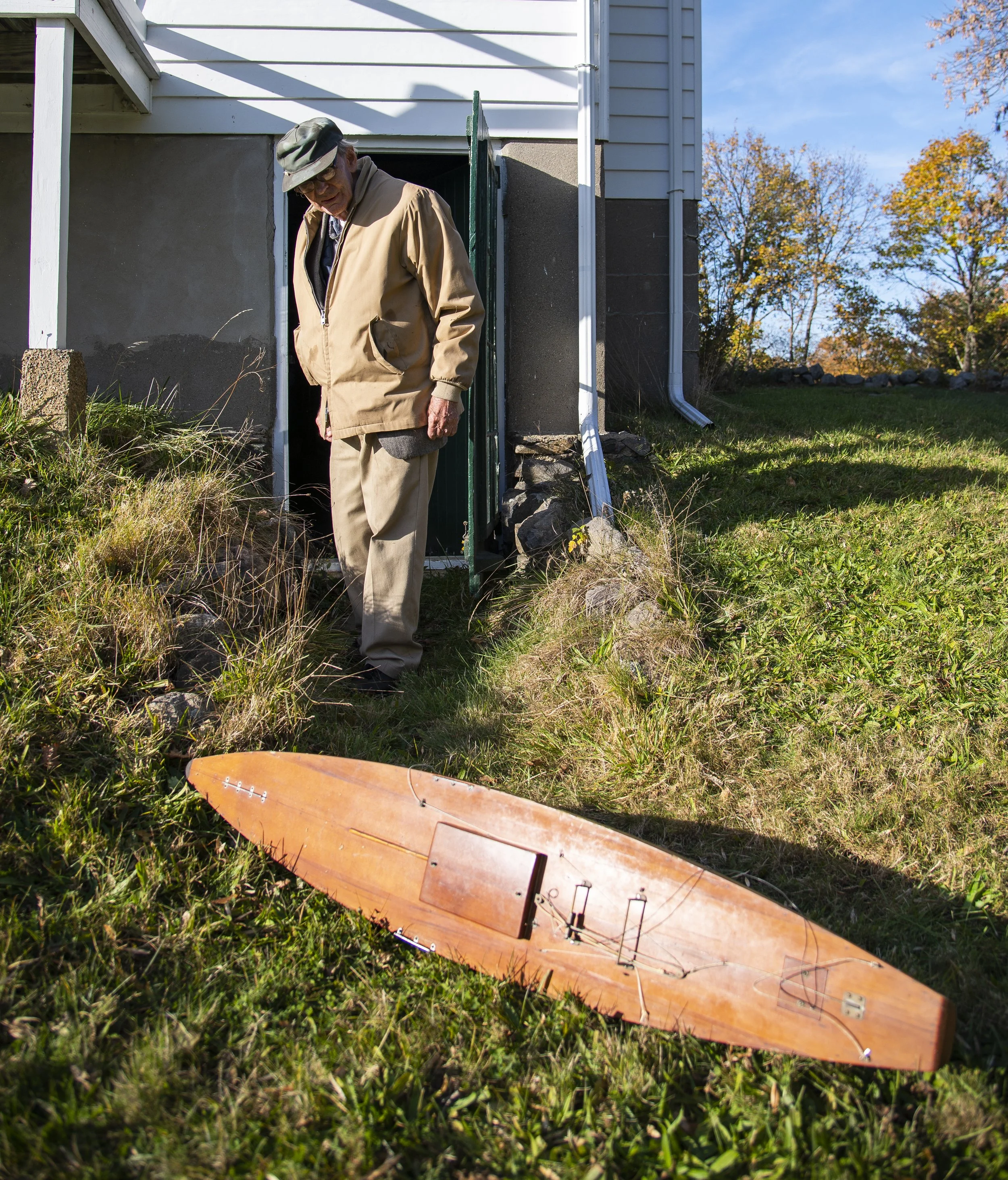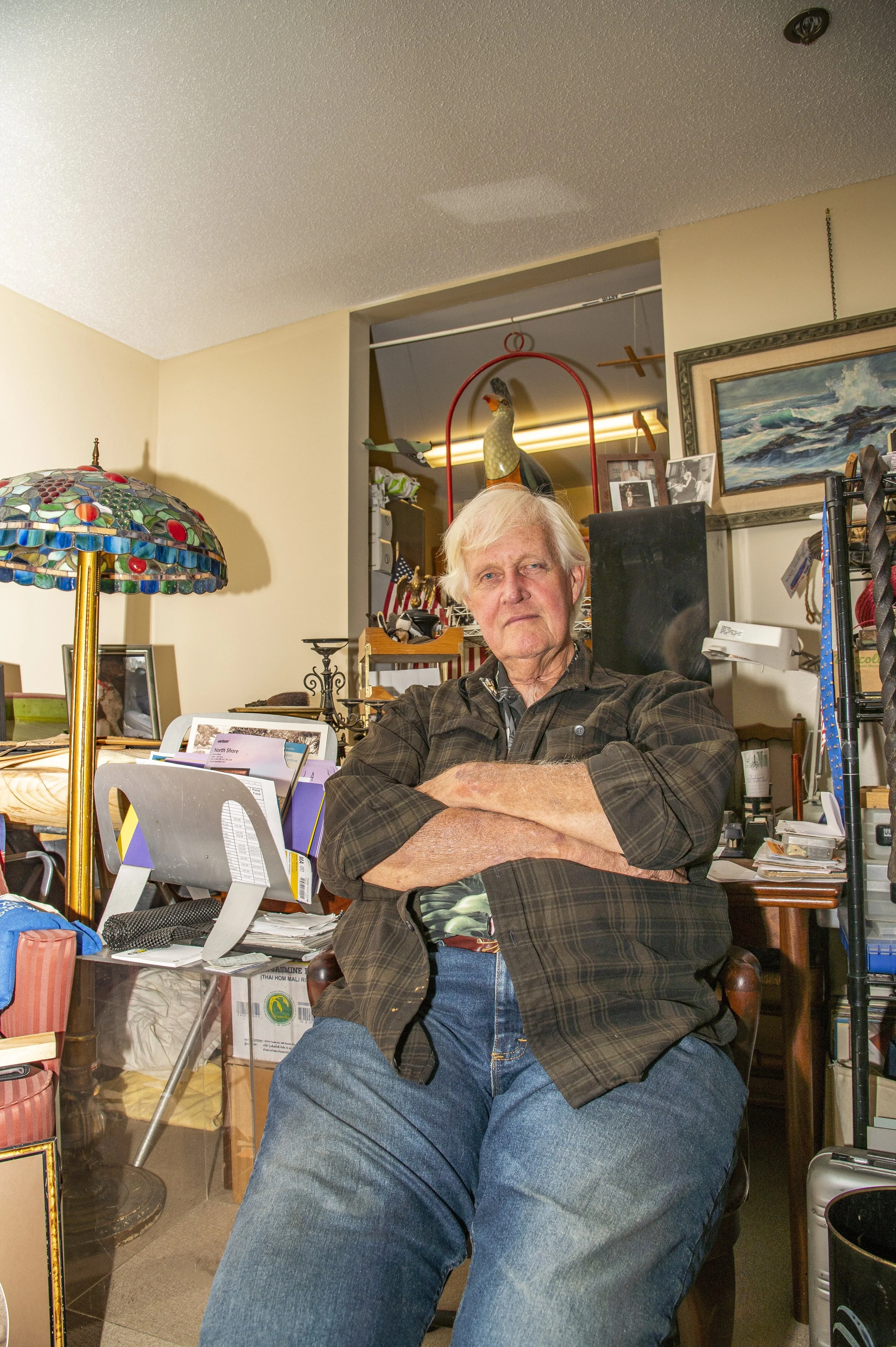A Marblehead 50-800 class model yacht named Harriet floats around Redd's Pond before a race.
Sailing through a century of racing at Redd’s Pond
This story originally appeared in the 2021 Winter Edition of 01945 Magazine
MARBLEHEAD — The sound of a countdown clock reminiscent of a rocket launch sequence reverberates across the water and fills the air surrounding Redd’s Pond on a crisp fall day in October. Seventeen men arrayed in a tidy line stand on the concrete edge just near the water.
Each of them holds a radio transmitter.
They listen intently for the telltale twang of an animatronic bell, the start of a sight familiar to Marblehead residents: a yacht race — but not one coursing across coastal waters bordering the town.
Seventeen model yachts, as they’re officially called, cross over the starting line at a blistering speed of maybe a full knot. There are no motors in these boats — they’re powered by the wind and controlled by their captains who can change the direction of their sails with the flick of a joystick.
The competition is stiff at the Chowder Regatta, an annual race that, as you may have guessed, serves a chowder lunch, and is hosted every year at Redd’s Pond by the Marblehead Model Yacht Club (MMYC).
The miniature models of sailing yachts are hand-built to meet specific classifications. The most popular model raced at Redd’s is, of course, the Marblehead 50-800 Class, so named because the boats were to be made 50 inches long, with 800 square-inches of sail space.
Model yacht racing at Redd’s can be traced back to as far as 1892 when a version of the club first began setting sail. A member of the MMYC, Roy Clough, is credited with helping to create the iconic M class in 1930, which would go on to become one of the world’s most widely-used model yacht classes for pond racing.
The first model boats were called "free sails," and were controlled solely by the wind and a small feather on the back of the boat.
Standley Goodwin, an 83-year-old engineer whose work on missile-guidance systems at Draper Laboratories helped put Neil Armstrong on the moon, has lived in a white wooden house with views of Redd’s Pond his whole life, “except for the first two weeks,” as Goodwin will say. His parents hand-built it in 1937, gifting the home to him after their passing.
He laughs when asked what age he started sailing: “The minute I was old enough to buy a boat,” Goodwin says with a smile. Though he had been building and sailing for a few years before he was 16, it was in 1954 that he officially joined the MMYC.
Left: Standley Goodwin, an engineer whose work on missile-guidance systems at Draper Laboratories helped put Neil Armstrong on the moon, looks down at one of his racing models that's nearly 60 years old.
Goodwin credits himself with the success that the MMYC would have in the following years in terms of membership.
“The club had virtually died at that point. The older members were having meetings, but they weren't sailing. There were a half-dozen younger kids who got interested all at the same time; we kind of resurrected the affair, and we've been sailing there ever since.”
Memorabilia from Goodwin’s sailing days are spread throughout his house in every nook and cranny that can afford the space: boats, sails, national sailing magazines, and plaques from his various title victories.
Many of those plaques include National Championship titles, a race that Goodwin has won eight times throughout his multi-decade sailing career. His first was in Toronto, Canada in 1974, a race in which Goodwin “came out of nowhere” to secure the title while racing among the bigwig sailing names of the time.
Nowadays, Goodwin mostly stays away from the spotlight and traveling that earmarked his more successful years as a model sailor. Now he mainly sails on Sundays, one of the MMYC’s official sailing days, though fewer and fewer boats are being launched at Redd’s Pond, in part due to the weather, but also due to a steady decline in membership over the past few years.
When Goodwin goes out now, he’s lucky to see even two other sailors out on the pond getting their boats wet. One of them that he can usually count on is the MMYC’s commodore, Benjamin Franklin Martin, though everyone calls him Biff.
Martin, also a Marblehead native who grew up a stone’s throw away from Redd’s Pond, deems the pond the “Mecca” of model yacht racing.
“This is where it all began,” says Martin. “It's where the Marblehead class began, and everyone loves to come and sail on Redd’s Pond even though it drives them nuts. The trees around it make it almost impossible to just come there and sail and win.”
Martin and Goodwin have been close friends for nearly 60 years and counting, in large part due to model yacht racing. Martin is quick to acknowledge that Goodwin is the most successful racer that Redd’s Pond has ever seen.
“He’s a piece of work. Every time that I’ve gone to Redd’s Pond I’ve gone to beat him, even when we were kids,” said Martin. “He's pretty good at what he does, but sometimes ― sometimes ― I can beat him. And he knows it.”
Though Goodwin may not remember, Martin’s first memory of the champion yachtsman was from when he was 3 years old.
“He’s always been a good friend to me. There's been times when he and I are the only ones that have sailed all summer long. We show up Sunday morning and race each other (for) 10 races,” Martin said.
Martin’s apartment in Marblehead, much like Goodwin's home, is chock-full of sails and boats, many old, but some new that he’s still repairing.
“It's an obsession," he said. "I mean how many places have you seen where somebody has a hobby that their whole apartment is taken over with?”
His obsession with model yachting is part of what has kept Redd’s Pond alive as a destination for model racing all these years. It costs nearly $3,000 every two years to cleanse the pond and keep it clear of algae, but the $25-per-person cost of membership to be a part of the MMYC unfortunately is a mere drop in the bucket, leaving the burden of expenses on Martin.
As to what the future holds for the Marblehead Model Yacht Club, Goodwin believes that’s in the hands of a younger generation of sailors who have yet to discover the passion of model yachting.
“The people who are members are all getting on, so we’ll just have to see. Some new group is going to have to take over in a few years,” Goodwin said.
Until then though, most Sunday mornings from April to December, any visitor to Redd’s Pond will witness the old guard still standing strong, watching over the pond as they’ve done for more than a century.
In their eyes, they’ve already done their part to leave their legacy in Marblehead. It’s up to someone new ― maybe even someone like you ― to set sail and carry on the tradition of model yachting at Redd’s Pond.








